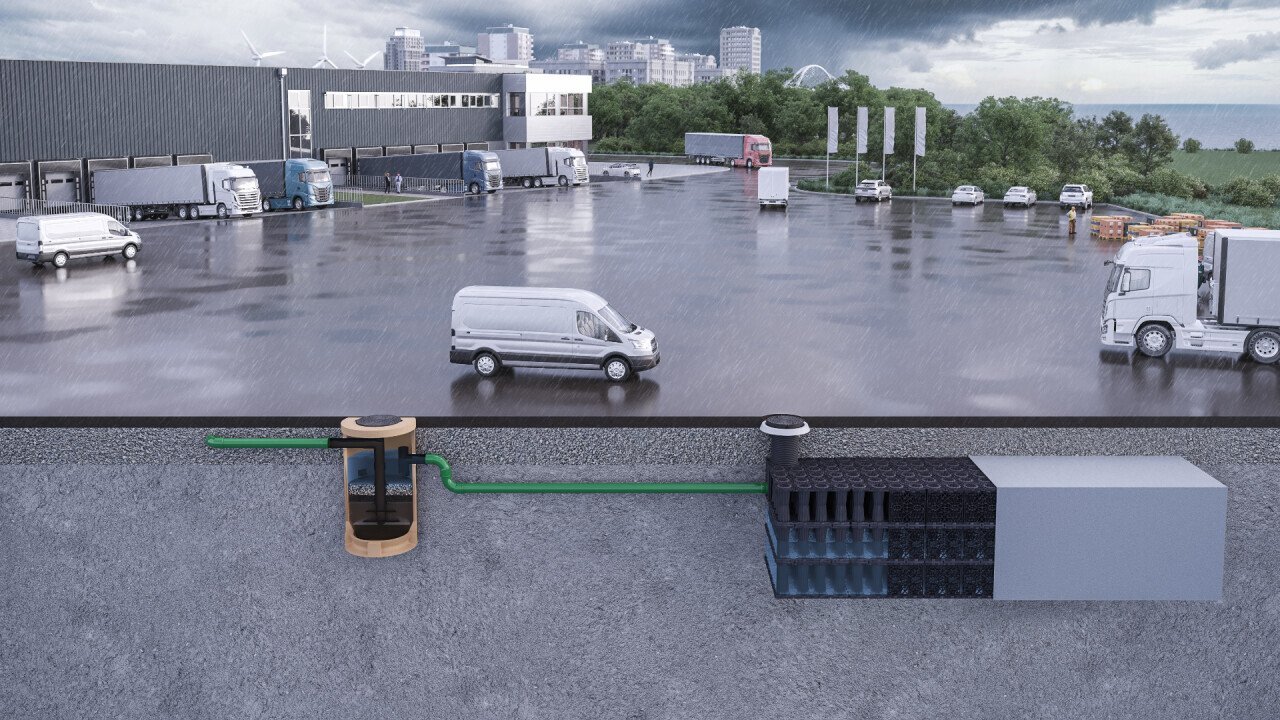Targeted rainwater management is becoming increasingly important and brings further positive effects. Technical filters relieve the burden on sewer systems and enable rainwater to be managed sustainably.
Sewer systems are often overwhelmed, especially during heavy rainfall. Targeted rainwater management is becoming increasingly important and brings further positive effects. Due to the increasing sealing of the soil as well as and infrastructure, the natural path of rainwater into the ground is largely prevented. The water is channelled directly into the sewer system. However, heavy rainfall events are increasingly pushing the absorption capacity of sewer systems to their limits - often with devastating consequences for the affected population. As a supplement to the tried and tested drainage systems, in which the water is mainly discharged into the sewer, there are a number of options for dealing with rainwater sustainably and thus relieving the burden on the sewer systems.
What to do with the surface water?
The aim of sustainable rainwater utilisation is to allow the water to seep away or evaporate.
Temporarily store it, utilise it and/or return it to the water cycle with a time delay. The type of utilisation depends primarily on the available open space:
- In the case of surface infiltration, the rainwater
infiltration, rainwater seeps into the ground via open, green or permeable paved surfaces.
- With swale infiltration, the rainwater drained from paved surfaces is temporarily stored in shallow, grassed swales before it infiltrates into the ground.
- Technical filters in underground tank systems transfer the cleaning function of rainwater to the subsoil and thus enable optimised use of space above ground.
- Infiltration trenches allow the water to seep into the ground via underground infiltration boxes.
seepage boxes into the subsoil.
- Roof and façade greening relieve the burden on the sewer network in densely built-up areas, buffer rainwater and make a significant contribution to air purification and heat protection.
What is surface water polluted with?
Surface water from busy roads and car parks as well as commercial and industrial areas is often contaminated with high levels of dirt and pollutants. These enter the water cycle through precipitation and originate from traffic or particulate matter in the air. Local conditions as well as wind and weather conditions influence the amount and concentration of pollution. Efficient solutions are therefore required for the sustainable use of water resources in order to clean surface runoff and prevent pollution of groundwater and surface waters.
Technical filter ACO Stormclean
ACO Stormclean forms the basis for professional and future-orientated rainwater treatment. Rainwater from heavily polluted traffic areas, yards and paths must be cleaned of pollutants and contaminants before it can seep away or be discharged into watercourses. In addition to coarse and suspended solids (GUS), heavy metals and trace substances such as pesticides are significant pollutants. ACO Stormclean reliably cleans these polluted surface runoffs in a compact tank made of polymer concrete and fulfils the highest standards according to the approval principles for rainwater treatment systems of the VSA or the DIBt.
The ACO Stormclean combines a defined sedimentation zone with a two-stage substrate filter stage. It is easy to control and clean through a central pipe. The height difference between the inlet and outlet is only 25 cm.
The filter material is easily accessible and must be replaced every three to four years, depending on the amount of dirt. As the system is installed under the road surface, it does not require any additional space on the property. The combination of solids separator and substrate filter is effective against both particles and dissolved water constituents. The treatment system is suitable for traffic areas such as car parks and roads with all traffic loads as well as for industrial areas and metal roofs. Even heavily contaminated rainwater runoff can be cleaned and discharged directly into surface water or groundwater.

- The rainwater is channelled downwards through the central pipe. The first light liquids can already be retained here.
- The patent-pending flow level with defined outlet openings calms the water so that sediments can settle on the way to the outside of the filter. An upper baffle plate ensures sufficient dwell time and an even flow through the filter substrate.
- The sediments can be extracted during maintenance/cleaning via an access that can be easily opened from above. The sludge traps of this series are sufficiently dimensioned in accordance with SN 592 000, so that the usual maintenance intervals can be expected.
- The core of the filter systems is a 50 cm thick substrate layer, which is clamped in the centre of the filter shaft. The separation layer was selected so that it is filter-stable to the grain size of the substrate, but still sufficiently permeable to prevent rapid clogging. In the substrate layer, the fines are filtered in the upflow process and a large proportion of the dissolved pollutants are precipitated and adsorptively bound.
- The filter layer can be backwashed and can be easily extracted and replaced with new substrate once the permitted service life has been reached or in the event of complete blockage. Here our customers can rely on the ACO service.
- The clean water is located above the filter elements and then flows via the drain into the infiltration system or a surface water body.
Find out more: aco.ch/de/stormclean

